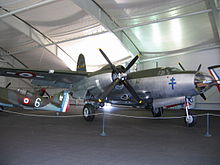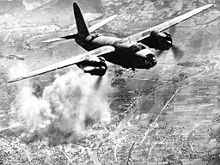Martin B-26
| Martin B-26 Marauder | |
|---|---|
 B-26B-55-MA of the 596th BS, 397th BG, 1944 |
|
| Type: | bomber |
| Design country: | |
| Manufacturer: | |
| First flight: |
November 25, 1940 |
| Commissioning: |
1941 |
| Production time: |
1941 to 1945 |
| Number of pieces: |
5266 |
The Martin B-26 Marauder (dt .: Plunderer ) was a medium-weight, twin-engine, medium- range bomber of the time of the Second World War from American production. The manufacturer was the Glenn L. Martin Company . Designed as a shoulder- wing aircraft , it emerged from a tender by the US Army on January 25, 1939 for a medium bomber with very high flight performance. From 1940 to 1945 5157 machines were built. The aircraft was used during the Second World War, first in the Pacific War and later in Europe. The letter "B" in the name stood for bombers .
development

Of the greatest importance were the requirements for the maximum speed of 300 mph , corresponding to 480 km / h and a large bomb load. This demand was prompted by reports from Europe about the capabilities of the German Air Force , particularly the detailed messages and views from Charles Lindbergh .
The Glenn L. Martin Company offered a streamlined aircraft with relatively small wings and two powerful engines. The contract was awarded to the model 179 from Martin, which was designated the B-26 Marauder. Due to the urgency, the usual prototypes for testing were not used. In September 1939, 201 aircraft were ordered from the drawing board; the maiden flight was on November 29, 1940.
These first copies of the aircraft had a wingspan of 19.81 meters and were designated B-26, powered by two Pratt & Whitney R-2800 -5-Double-Wasp- double radial engines with 1850 hp each. The armament consisted of three 12.7-mm machine guns and two 7.62-mm machine guns and a bomb load of 2179 kilograms.
This was followed by the B-26A model, of which 139 were built. This model had, among other things, an approximately 100 kilograms higher take-off weight, additional tanks in the bomb bay and a stronger bow and stern armament as well as a suspension for a torpedo . Two Pratt & Whitney R-2800-9 and -39 with 1850 HP (1380 kW) served as drive.
The B-26B was the next development stage, it was initially equipped with the 1850 hp engines, but these were soon replaced by the more powerful R-2800-43 engines with 1920 hp take-off power. The armament was again reinforced; the B-26B received a 7.62 mm machine gun in a tunnel under the fuselage and the rear armament was doubled to two 12.7 mm machine guns. In addition, the crew was protected by stronger armor. Together with the conversion to the more powerful engines, the tunnel machine gun was replaced by two 12.7 mm machine guns for side defense. In order to improve the slow flight characteristics, a drastic change was carried out from lot B-26B-10: In an effort to reduce the wing loading and thus the problems with flying handling in slow flight, the wingspan was increased by 1.83 meters to 21, 64 meters longer, which increased the wing area by 5.2 square meters. The tail unit was also enlarged.
Again the armament was reinforced, the B-26B received four rigid 12.7 mm machine guns on the side of the fuselage and a second bow machine gun; the rear stand was replaced by one from Martin-Bell. A total of 1883 B-26Bs were built.
The B-26C were principally B-26B-10 and were built at the new Omaha plant in Nebraska . 1235 machines were made.
Only one copy of the B-26D and E was built, they were test aircraft.
A major change has been made to the B-26F. In order to improve the take-off and landing properties, the angle of incidence of the wings was increased by 3.5 to 7 degrees, which at the same time increased the distance between the propeller blades and the ground slightly, which was an advantage on unpaved airfields. 300 copies of the F version were built.
The last production variant was the B-26G, it differed only in details from the B-26F. 893 copies were built.
Other variants of the B-26 were the AT-23A, a rifle trainer version of the B-26B, the AT-23B, a trainer version of the B-26C and the TB-26G, an unarmed trainer and target tug. There was also a single XB-26H for testing a four-wheel landing gear with two double wheels under the fuselage, as was later used on the Boeing B-47 .
The United States Navy also flew the Marauder , but almost exclusively as a target tug plane. 225 AT-23B took over the Navy from the USAAF under the designation "JM-1", of which a few were converted to "JM-1P" reconnaissance aircraft. This was followed by 47 newly built “JM-2”, which essentially corresponded to the TB-26G.

The Royal Air Force also flew the Marauder. Under the Loan and Lease Act , 52 Marauder Mk I (B-26A), 19 Mk IA (B-26B), 100 Mk II (B-26C) and 350 Mk III (B-26F / G) were delivered to the UK.
use
Initially, the use of the insufficiently tested machines by the troops was problematic. The high requirements of the tender required a high wing loading , which resulted in high take-off and landing speeds. For inexperienced pilots this meant critical flight behavior at low speeds and at the beginning of its career the B-26 acquired the bad reputation as a death trap for its crews ("widowmaker"). As the training accidents increased, a committee of inquiry was set up to consider discontinuing production. However, the committee proposed changes that improved slow flight characteristics, resulting in the Model B-26B-10. After that, the B-26 was the aircraft with the lowest casualty rate in the US 9th Air Force in Europe.
The first unit equipped with a B-26 Marauder became operational in December 1941. Their "baptism of fire" was the B-26 on April 5, 1942 in an attack on the by the Japanese army occupied Rabaul . Later it was used in all theaters of war.
Since the Marauders were initially used mainly in low-level attacks because of their high speed, the first combat missions were characterized by considerable difficulties and losses. After a loss-making operation on May 17, 1943, during an attack on Ijmuiden , ten of the eleven B-26s were shot down by German flak - the remaining machine had stopped the attack due to technical problems, the tactics were changed and only B-26s were used still used at medium heights.
In the end of the war, the Marauder was a dreaded tactical air support because of its high speed and heavy armament. Their high wing loading remained problematic, but as the war went on, the pilots had enough experience to cope with it. Overall, the losses on B-26s were the relatively lowest of all American combat aircraft.
production
Approval of the B-26 by the USAAF:
| Manufacturer | version | 1941 | 1942 | 1943 | 1944 | 1945 | TOTAL |
|---|---|---|---|---|---|---|---|
| Martin, Baltimore | B-26 | 201 | 201 | ||||
| B-26A | 62 | 77 | 139 | ||||
| B-26B | 640 | 1149 | 193 | 1982 | |||
| Martin, Omaha | B-26C | 86 | 1215 | 284 | 1585 | ||
| Martin, Baltimore | B-26F | 300 | 300 | ||||
| B-26G | 774 | 176 | 950 | ||||
| AT-23 | 109 | 109 | |||||
| TOTAL | 263 | 803 | 2473 | 1551 | 176 | 5266 |
Technical specifications
| Parameters | Data of the B-26G |
|---|---|
| crew | 7th |
| length | 17.22 m |
| span | 21.65 m |
| height | 6.20 m |
| Wing area | |
| Wing extension | |
| Empty mass | 11,500 kg |
| Takeoff mass | 17,300 kg |
| Top speed | 455 km / h at 1530 m altitude 441 km / h at 4572 m altitude |
| Service ceiling | 6040 m |
| Range | 1760 km |
| Engines | two Pratt & Whitney R-2800 -43-Double-Wasp- twin radial engines, each 1,920 PS (approx. 1,410 kW) |
| Armament | eleven 12.7 mm Browning machine guns , 1815 kg (4000 lb ) bomb load |
Received aircraft (selection)
- B-26G (serial number 43-34581), National Museum of the United States Air Force near Dayton, Ohio
- B-26G (serial number 44-68219), Musée du Débarquement Utah Beach near Sainte-Marie-du-Mont, Manche , France
See also
literature
- Olaf Groehler: History of the Air War 1910 to 1980. Military publishing house of the German Democratic Republic, Berlin 1981.
- Kenneth Munson: Bombers, patrol and transport aircraft 1939–1945. 3rd edition, Orell Füssli , Zurich 1977.
- Chris Westhorp (Ed.): Thunder in the Heavens - Classic US aircraft from World War II . German-language edition, Karl Müller Verlag, Erlangen 1995. ISBN 3-86070-364-1
Web links
Individual evidence
- ↑ a b Martin B-26G Marauder. In: Fact Sheet. National Museum of the US Air Force, July 21, 2015, accessed November 14, 2016 .
- ↑ according to Olaf Groehler: History of the Air War 1910 to 1980 , Military Publishing House of the German Democratic Republic, Berlin 1981, p. 399 6678 units were built
- ↑ Statistical Digest of the USAF 1946 , p. 100 ff .; www.uswarplanes.net
- ^ The Utah Beach D-Day Museum. In: Musée du Débarquement Utah Beach. Mairie de Sainte Marie du Mont, accessed on November 14, 2016 (English): "Admire an original B26 bomber, one of only six remaining examples of this airplane still in existence worldwide"


